| Columns Retired Columns & Blogs |
Aerial Model 5B loudspeaker Measurements
Sidebar 3: Measurements
My estimate of the Model 5B's voltage sensitivity was 85.8dB(B)/2.83V/m, which is within experimental error of the specification. Though this is a couple of dB lower than average, as I commented in my auditioning notes, the speaker did sound less sensitive than I would have expected. The speaker's impedance (fig.1) is almost identical to that of the original, with an average level of 10 ohms in the midrange and above, but a drop to 4 ohms in the upper bass and a demanding combination of 6 ohms and a –40° electrical phase angle at 100Hz. A 4 ohm–rated amplifier will work best with the 5B. The traces in fig.1 are free from the small discontinuities that would indicate the existence of cabinet resonances; investigating the panels' vibrational behavior revealed a low-level mode at 563Hz (fig.2), as well as a slight degree of liveliness in the upper bass. While this behavior could be heard with a stethoscope pressed against the surfaces, there was no emphasis of any tones at the listening position.
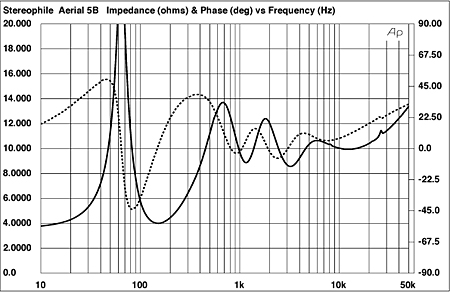
Fig.1 Aerial 5B, electrical impedance (solid) and phase (dashed). (5 ohms/vertical div.)
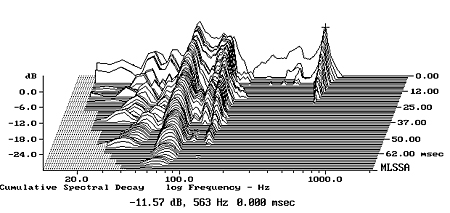
Fig.2 Aerial 5B, cumulative spectral-decay plot calculated from output of accelerometer fastened to center of side panel (MLS driving voltage to speaker, 7.55V; measurement bandwidth, 2kHz).
The impedance peak at 65Hz suggests that this is the tuning frequency of the sealed enclosure, which will correspond with the speaker's –6dB point. Measured in the nearfield, the 5B's output peaks up in the upper bass (fig.3, red trace below 300Hz), and while most of this boost will be a measurement artifact, it does appear that the speaker's LF alignment is a little underdamped. In this respect, the 5B is identical to the original Model 5 (fig.3, blue trace). Overall, the 5B's upper-frequency behavior (red trace) is almost identical to that of the original (blue), though the new tweeter's ultrasonic dome resonance is considerably more pronounced than the earlier driver's. Both speakers share a relative lack of energy in the midrange; I wonder if this correlates with the slight reticence in the speaker's sound.
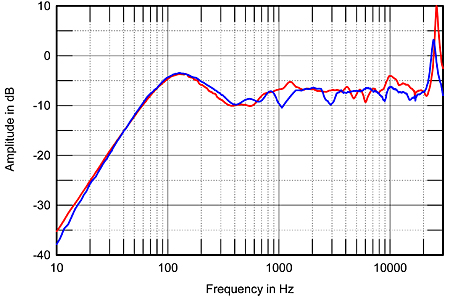
Fig.3 Aerial 5B, anechoic response on tweeter axis at 50", averaged across 30° horizontal window and corrected for microphone response, with nearfield response of woofer plotted below 300Hz (red). Blue trace shows response of 1997 sample of Model 5.
The new tweeter appears to cross over to the woofer at 3kHz (fig.4), which is slightly higher in frequency than the original. The 5B's lateral dispersion (fig.5) is wide and even below 9kHz, though with a very slight off-axis flare at the base of the tweeter's passband. As is usual with a 1" dome, the tweeter gets quite directional in its top octave. In the vertical plane (fig.6), a suckout develops in the crossover region above the top of the cabinet, meaning that the stand used should be high enough to place the tweeter on or just above the listener's ear height.
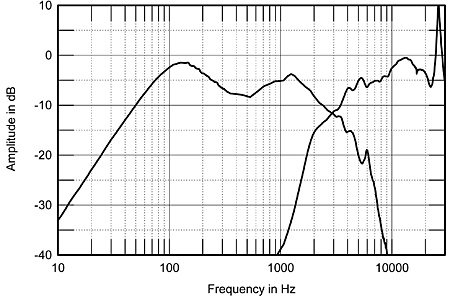
Fig.4 Aerial 5B, acoustic crossover on tweeter axis at 50", corrected for microphone response.
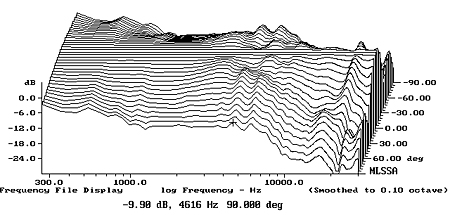
Fig.5 Aerial 5B, lateral response family at 50", normalized to response on tweeter axis, from back to front: differences in response 90–5° off axis, reference response, differences in response 5–90° off axis.
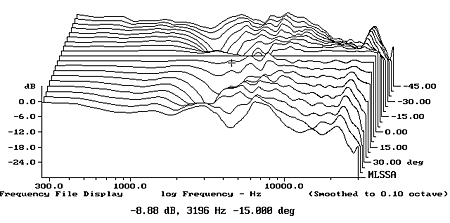
Fig.6 Aerial 5B, vertical response family at 50", normalized to response on tweeter axis, from back to front: differences in response 45–5° above axis, reference response, differences in response 5–45° below axis.
The red trace in fig.7 shows the 5B's spatially averaged response taken in a grid centered on the position of my ears in my listening chair, while the blue trace shows the response of the Acoustic Energy AE1 Mk.III Special Edition taken under identical conditions. The British speaker has noticeable excesses of energy in the mid-treble, which made it sound brighter than the American speaker—as well as in the midrange, which made it sound less reticent. The reflex-loaded Acoustic Energy produces a little more upper-bass energy than the Aerial, but the latter's sealed-box loading results in a slower low-frequency rollout, meaning that the speaker excites the lowest-frequency resonance in my room, around 30Hz, to a greater extent.
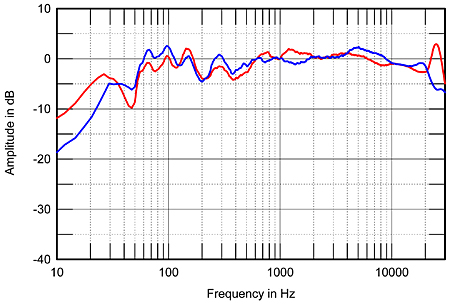
Fig.7 Aerial 5B, spatially averaged, 1/6-octave response in JA's listening room (red); spatially averaged, 1/6-octave response of Acoustic Energy AE1 Mk.III Special Edition (blue). (10dB/vertical div.)
In the time domain, the 5B's step response on the tweeter axis (fig.8) indicates that both drive-units are connected in positive acoustic polarity, while the cumulative spectral-decay plot (fig.9) is superbly clean—even cleaner than the original's, which correlates with the grain-free highs I noted in my auditioning.—John Atkinson
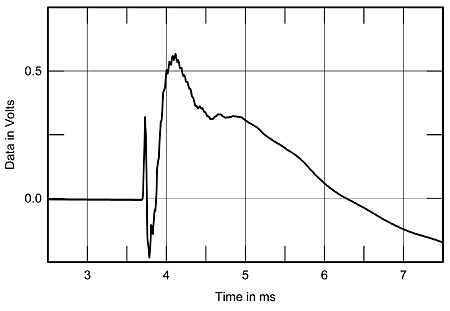
Fig.8 Aerial 5B, step response on tweeter axis at 50" (5ms time window).
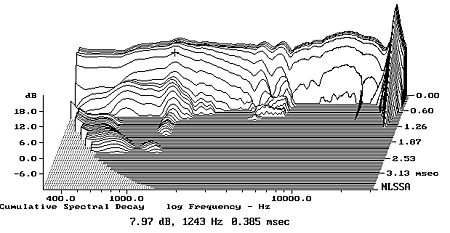
Fig.9 Aerial 5B, cumulative spectral-decay plot on tweeter axis at 50" (0.15ms risetime).
- Log in or register to post comments




































